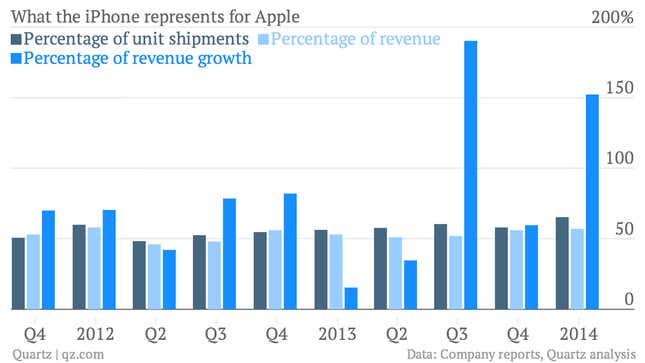
While new gadget categories—such as the supposedly forthcoming “iWatch”—could fetch Apple plenty of attention this year, and take some pressure off CEO Tim Cook, the bulk of its growth is more likely to come from a familiar source: The iPhone, which will be 7 years old this weekend.
For some perspective on this, former Apple executive Jean-Louis Gassée wrote this week, “The most ambitious rumors project 50 million iWatches sold in the first 12 months. I think that’s an unrealistic estimate, but if a $300 iWatch can sell at these numbers, that’s $15B for the year. This seems like a huge number until you compare it to a conservative estimate for the iPhone: 50 million iPhones at $650 generates $32B per quarter.”
Over the past several years, the iPhone has generated more than half of Apple’s revenue and likely more of its profits. (Apple doesn’t disclose gross margin per product line, but it’s widely estimated that the iPhone is the company’s most profitable product line, thanks to its high pricing and mobile-operator subsidies.)
The iPhone also drives a disproportionate amount of Apple’s growth. Over the past ten reported quarters, the iPhone has generated more than half of Apple’s new revenue—measured versus the prior year—seven times. Twice, it has represented more than 150% of Apple’s growth, meaning it more than offset year-over-year declines in other product lines, such as the iPad and Mac.
A particularly successful (or unsuccessful) iPhone 6 launch this year, therefore, could have oversized effects on Apple’s business, as growth has slowed. Indeed, if a successful iPhone 6 can even help Apple sell 25% more iPhones than it did over the past year—200 million instead of 160 million—that’s $26 billion in potential new revenue. Much more than the iWatch is likely to generate right away.